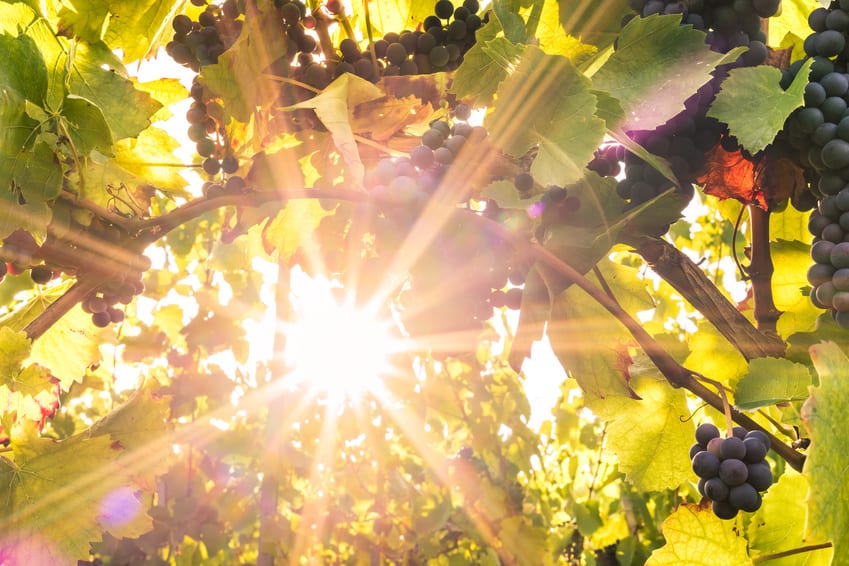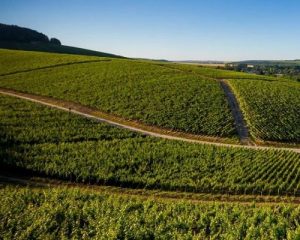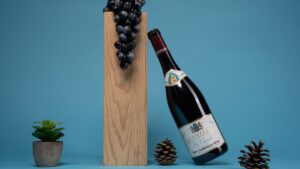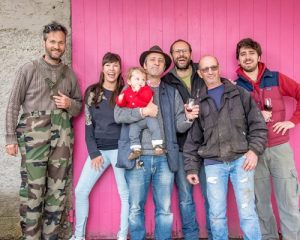 The summer is coming to a close and has made headlines all over the world for its record-breaking temperatures, deadly heatwaves and forest fires. But do high temperatures make a good vintage? How exactly does warm weather influence the wines currently in the production? What’s the difference between a northern and a southern wine? And just how good are vintages from swelteringly hot years? Here’s the full story – more or less…
The summer is coming to a close and has made headlines all over the world for its record-breaking temperatures, deadly heatwaves and forest fires. But do high temperatures make a good vintage? How exactly does warm weather influence the wines currently in the production? What’s the difference between a northern and a southern wine? And just how good are vintages from swelteringly hot years? Here’s the full story – more or less…
A quick reminder about vines
First of all, bear in mind that a wine’s aroma and flavour derive from either the grape, or from the fermentation or maturation processes. And in fact, most of what you smell or taste comes from the grape itself (in the case of conscientious growers, at least). A wine with a scent of white flowers hasn’t been macerated with actual flowers. The grower has simply used a grape variety which produces this organoleptic profile. Improvements in vinification techniques can fine-tune the final taste of the wine, but the grape is still the key factor.
Of course, the vine is a plant, and its fruit needs sunlight to ripen. As the grapes mature, their sugar levels increase. The subsequent stage of vinification consists of using yeast to convert the sugar in the juice into alcohol. This is known as alcoholic fermentation.
The more sugar is contained in the juice, the more alcohol there will be in the resulting wine. This is therefore referred to in short as “potential alcoholic content” when measuring the concentration of sugar in the grape.
And just like any other plants, vines need water. However, water spraying is (with a very small number of exceptions) prohibited for French vines. Why? Because the tougher the conditions for the vine, the more concentrated and complex the wine it produces. This forces the wine to draw deeply on its reserves to find the resources it needs to produce wine. However, extended periods of drought create what biologists refer to as “plant water stress”, a condition where the vine is no longer able to supply itself sufficiently, and the grapes are smaller and (paradoxically) less ripe, as the vine neglects its fruit and concentrates solely on its own “survival”.
In short: drought = smaller grapes = lower quantity.
However, it is easier to take action when there is too much sunshine than when there is too little.
Physiological maturity and phenolic maturity
The alcohol in a wine gives it an impression of “warmth” in the mouth. A successful white wine needs to contain a sufficiently high acidity level to balance out its alcoholic content. The equilibrium between alcohol and acidity is known as physiological maturity. In the case of red wines, another factor needs to be considered: tannins. These molecules are found in the grapes’ skins, stems and pips. In addition to physiological maturity, a grower has to pay attention to the phenolic maturity of red wines, which determines the quality of the colouring matter (anthocyanins) and tannins (polyphenols). Phenolic maturity is deemed to have been reached when the pips are ripe (and generally dark in colour) and, on tasting, have lost almost all of their pungency in the mouth.
The problem is that the two types of maturity rarely coincide. A wine which has achieved an alcohol potential of 13 degrees without having reached phenolic maturity will produce a wine with hard or even “green” tannins. In years of too little sunshine, it is also possible that neither maturity level will be achieved.
What about in the glass?
When blind-tasting a wine, the first question you should consider is: is the wine warm or fresh? If it’s a fresh wine (with a sensation of acidity in the mouth), it’s more likely to have come from northern France. If it’s warm, the chances are it originated in the south. The grape variety is almost always matched to a region’s climate: for example, Pinot Noir needs less sunshine to reach maturity than Cabernet does. In years characterised by an unusual climate (very cold or very hot), there may be a lack of balance between acidity and alcohol.
In practical terms, a white wine from the north (Muscadet, Sauvignon from the Loire, Burgundy, Alsace, etc. ) will develop fresh aromas of white flowers and citrus on the nose. There will be a marked acidity in the mouth. This produces “taut” wines. For wines from the South of France, aromas will tend towards yellow fruit, beeswax (honey, wax, etc.) and even scrubland aromas. In the mouth, they will be meatier, with more richness. The finish can be very warm in some cases (for example, wines based on Grenache blanc). Note, however, that wines from the South are not “sweetened”, despite what many newcomers seem to believe. Residual sugar (i.e. sugar not converted to alcohol) can be obtained both in the North and the South of France.
Red wines from the North generally feature aromas of small red berries (raspberry, wild strawberry), with a distinct acidity in the mouth and a fresh finish. Reds from the South generally tend to be warmer, with more structure. Their aromas tend more towards black berries (blackberry, blackcurrant). In the mouth, the more obvious presence of alcohol gives an impression of warmth and power (for example, in Châteauneufs). The alcohol can sometimes produce a sweet sensation.
How do growers handle these issues?
The first response to a lack of sunshine is leaf thinning. The more the leaves are cut back, the more exposure to the sun the grapes receive (although leaf thinning is generally performed late in the summer).
The second strategy, of course, is to change the harvesting date. This can be decided in advance, as was the case in 2016 when physiological maturity was reached. If not, however, it can be postponed. In 2014, this decision was rewarded with a fantastic Indian summer. However, it can be a risky gamble: if the rain or the temperature falls, the grapes can be attacked by rot. Some growers – such as Gauby in Rousillon – took a blanket decision to harvest very early to obtain wines which were lighter, more delicate and with a lower alcohol content. The problem in that case, however, is achieving sufficient phenolic maturity…
Harvesting can be performed in a series of passes to achieve perfect maturity. Lastly, selective picking is another useful tool. Under-ripe or over-ripe grapes should be rejected. Extreme vintages are precisely the time when the differences between estates are most keenly observed.
Lastly, vinification provides the winemaker with an opportunity to correct the profile of a wine. Vinification can be conducted for a longer or shorter time in order to extract more or less matter, and winemakers can also emphasise malolactic fermentation (or not). This occurs after alcoholic fermentation, and serves to reduce the acidity of a wine by converting malic acid into the less prominent lactic acid. Winemakers generally use this technique for red wines and white wines from Northern France. Under exceptional circumstances, winemakers can opt to halt this second fermentation to retain more acidity.
The climate crisis: a threat or an opportunity?
The simplest answer is that it depends. Generally speaking, a grower has more available options in years that are too hot than in those that are too cold. Even so, global warming presents an opportunity for northerly vineyards. Consider England, for example, which sees its chalky southern vineyards as the future Champagne. Aubert de Villaine, an owner in Romanée-Conti, thinks Burgundy may stand to gain too. It would ensure fewer years with insufficient maturity, which is a fairly common problem in the more northerly French vineyards.
However, there is a question mark over the southern vineyards, which could suffer in the future. The consequences of global warming have been severe in Banyuls in particular, where numerous studies have been conducted. Here, wines have gained one degree of alcohol every 10 years over the last 30 years. Back in the 1980s, harvesting would start in mid-September, whereas now it is at the beginning of the month. And harvesting in hot weather can be detrimental to the quality of the grapes (premature oxidation of white wines, etc.).
A radical solution would be to change the grape varieties grown in these regions. However, before going that far, salvation could lie in the choice of clones which cope better with high temperatures. The INRA research institute is currently working on viticulture and vinification solutions in an attempt to reduce alcoholic strength – something which would have been unthinkable 30 years ago. In any case, it’s to be hoped that global warming won’t exceed two degrees if the southern vineyards are all to survive.
Sun-drenched vintages: buy or avoid?
The most recent example is the 2003 vintage. It was widely fêted in Bordeaux at the time. And yet today, many of its wines are completely “cooked”, developing prune-like notes, lacking acidity, etc. However, that doesn’t mean the 2003 vintage is dead and buried… far from it. Results are patchy, but there are some absolutely superb wines out there. It’s worth examining wines from cooler terroirs: for example, Saint-Estèphe has taken advantage of its clay soil, which acts as a large water reservoir.
These sunny years generally work to the advantage of the large estates. This is partly because the average age of the vines is greater: their roots can obtain water from deeper in the ground. Another reason is that these estates are willing to reduce their yields through drastic selection of their grapes. Lastly, some great terroirs enjoy a more favourable geographical location. In the Médoc, the great châteaux are considered to be those with a view of the river. And it’s true, with their proximity to the Gironde; Latour, Las-Cases, Pichon-Comtesse, Calon-Ségur, Phélan, etc., enjoy a more temperate climate than is the case further inland, protecting their vines from the frosts of winter and the hottest days of summer…
See our full selection of wines here



